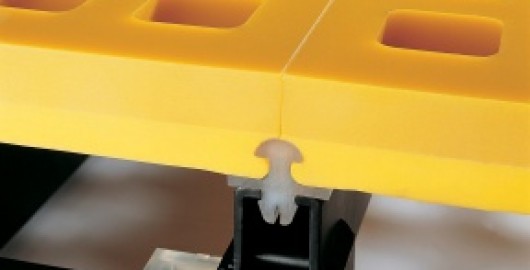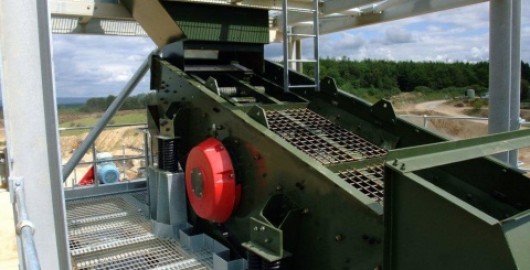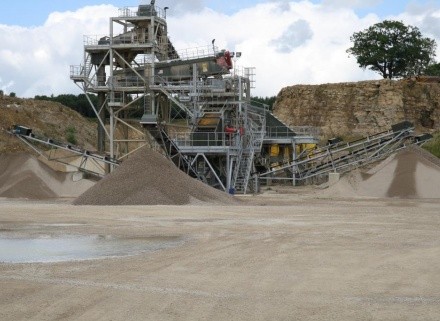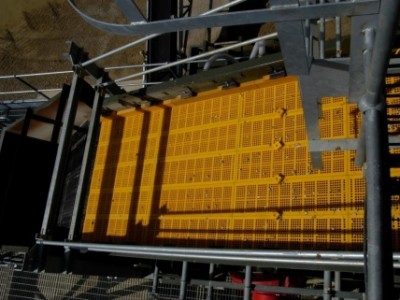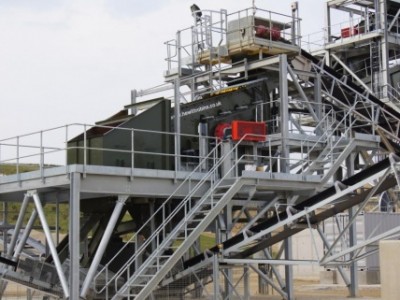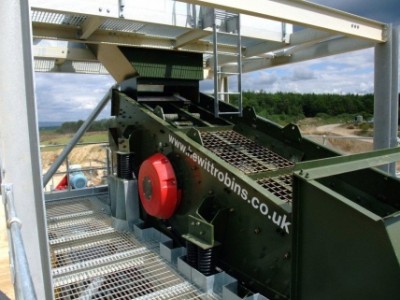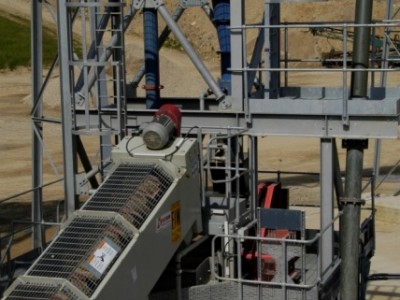New wash plant at Lightwater Quarries delivers increased production with ease.
5 November 2013
Owned and operated by Lightwater Quarries Ltd, Potgate Quarry lies near Ripon, North Yorkshire.
Part of a family owned local business, quarrying started in the 80’s and in recent times the company has experienced a growing market in the demand for aggregates to be used in concrete or filter drainage materials. This change in demand has recently made the company to focus on premium products, such as sand and small sized washed limestone, instead of crushed rock for fill. This made sense for several reasons as Potgate Quarry is well known for a quality of limestone not usually found in North Yorkshire. Furthermore, there is an imbalance in North Yorkshire between hard rock and sand and gravel deposits, as there are quite low sand and gravel reserves.
When Lightwater Quarries decided to improve the quality of their materials by washing, this has allowed them to produce an end product that would normally be produced from a normal sand and gravel operation. This decision has a positive environmental effect by helping to preserve the land bank in North Yorkshire by not depleting the natural sand and gravel reserves. All of which became the main drivers behind the decision to invest £1.5 million in a new wash plant.
Now successfully commissioned and running David Roberts of the HUB went along to talk about the new plant and see it in operation.
Design from experience
After committing to the new wash plant Kevin Parker – General Manager at Potgate spent some time to review what was currently available on the market that would be suitable for the proposed production, and also fall ‘in-line’ with his experience and the flaws he had spotted on other plants whilst making a decision on whether to utilise a log washer, or a barrel in the process line. Kevin then asked Whitwick if they could design a ‘walk around’ the plant to follow the process.
Consequently Whitwick then designed a structure of galvanised steel allowing personnel to ‘walk’ the process in order, providing permanent easy access to every element of the plant; including all the screens and logwasher (all fitted with handrails around the perimeter), and a permanent access ladder to enable safe access for maintenance.
Ed Reed – MD - Whitwick Engineering, commented, “The plant was designed with generous access for ease of maintenance as well as a considerable amount of detailed design attention to achieve the lowest possible long term cost of operation and ownership in terms of both energy consumption and repair and maintenance costs.”
With Whitwick Engineering of Coalville installed as main contractor, layout design and supplier of the galvanised plant structure and supervision of the whole build, the civil work commenced in February 2011. After been delayed by the worst winter for decades Lightwater personnel utilised their own on-site volumetric concrete trucks to make C40, completing the fully slabbed footprint which accounted for the plant and surrounds by September 2011. However, the plant wasn’t fully commissioned for a further six months until a larger electricity supply was made available in March 2012.
The wash plant
All the process equipment for the new plant including the sand plant was specified and supplied by Syscom, with Whitwick subsequently building a plant around it. With sticky clay being the main operational issue the decision was made to purchase a large log washer, with a second-hand one being purchased and refurbished.
The equipment utilised included:
- Eagle Iron Works(EIW) – 46” x 35’ long Log washer
- EIW - 30” x 25’ Fine Material Washer
- Krebs Gmax20 Cyclone and SlurryMax 6 x 6-17
- 1.6m x 4.2m Heavy-Duty Single Deck Scalping Screen
- 1.8m x 6.0m Triple Deck Washing Screen
- 1.6 x 4.2m Triple Deck Washing Screen
- Single Deck Dewatering Screen
- Tema Isenmann screen media - ‘PS-Gitter’ pressure welded wire mesh
- Tema Isenmann screen media - WS85 modular polyurethane.
Guido Pas – MD - Syscom BV, commented, “Kevin Parkers’s request was simple: provide a solid plant that doesn’t break down, and that allows us to supply really clean products to all our customers. This all sounded very simple, but having seen their deposit it was clear that they needed the best equipment available. The deposit can be extremely dirty with patches of tough non-soluble clay and up to 50% silt so we designed the plant around the two critical factor. This meant supplying the heaviest scrubber available (EIW 46 x 35) and a reliable sand washing system to wash out the high silt content with minimal wear. The combination of a 30” x 25’ EIW fine material washer and a Krebs Gmax 20 cyclone ensures the process.
The wash plant is fed from a remote tracked primary crusher fitted with a live roll grizzly, and no vibrating tray feeder, basically a long series of rollers that separates the clay from the rock. The crushed product meets the full specification for adoptable MOT Type 1 and all the material that falls through the grizzly is the material that is washed. This material is then transported by dumper to an 85 tonne dump hopper which is wide enough to take a 35 tonne dumper load. This dump hopper is designed with a very wide, slow moving belt which is the same width as the dumper, ensuring that it feeds material slowly. It then discharges onto a conveyor set at a 90° angle. This ensures that because the material is so sticky there is no funnelling taking place; the concept being that it falls off the big wide belt onto a conventional inclined conveyor in such a way that there is no channelling effect, subsequently making it thinner, thus eliminating any possible block-up.
Material then feeds up the long inclined conveyor which gains all the height that is required for the rest of the process. This ensures that the plant is gravity fed, the only uphill section being the finished material to stockpile. Although a tall plant this design eradicates any issues of ‘up or down’ the only dry material being the incoming uphill feed, based on the principle that once wet you don’t want it conveying again until it’s a finished product, as gravity resolves any issues.
Once at the top of this inclined conveyor the material then goes over the 1.6m x 4.2m heavy duty, single deck scalping screen. Fitted with Tema Isenmann ‘PS-Gitter’ pressure welded wire mesh this screen is designed solely to protect the 35’0” long log washer. Set specifically at an 85mm aperture (as the log washer can only take 100mm), water is then added at this stage to begin the process of breaking down the clay.
Material then goes into the EIW 35’ long log washer where more water is added. The log washer then munches up all the clay with the water weiring out of the back and the front, onto the first sizing screen - 1.8m x 6.0m triple deck washing screen (all of which are fitted with Tema Isenmann WS85 modular polyurethane screen media) which takes out the +40mm, 40-20, 20-5 and sand. The 20-5 product is then fed up onto another 1.6 x 4.2 triple deck washing screen which separates it into the 5mm/10mm and 20mm clean material. This is a wet screen so the water that is washed through is then recycled back into the log washer to create a little more water.
The sand that has come out of the sand deck goes into an EIW - slow moving screw which drags the grit and + 1mm out of the sandy liquor, this material is then fed onto a Hewitt Robins LPE-6 - 1.0 x 3.0 single deck dewatering screen (fitted with 0.5mm aperture -Tema Isenmann WS85 screen modules)forming a bed on the screen. The water and the bottom end of the sand then weirs off and goes into a sump, and is then pumped up into the Krebs Gmax20 cyclone. This makes an accurate cut of 70 micron and adds the sand onto the top of the bed of the coarse sand that is coming out of the screw. This results in a mixture of two sands, which effectively meets the specification for medium grit sand. This material is then conveyed up off the dewatering screen in a reasonably dry condition onto the stockpile.
The power system
With the new power supply in place a new transformer was installed to provide the 800kva required to drive the new wash plant. A purpose built control centre was the built and installed including an automated start-up in sequence with soft start, and timed shutdown through a simple stop button.
This control centre also offers a sophisticated control of the log washer. As the log washer bearings run in water the system monitors the water supply and if the water supply drops to a certain level it activates an alarm. If it drops any further it actually stops the process sequentially, or stops completely. The log washer is driven by a 160Kw motor and to save electricity the angle can be altered depending on how clean the material is. This is achieved by lowering the angle down so it doesn’t pull as much amperage, and equally so if the material is dirty so the material has more attrition to break down the clay.
A success
The new plant has been a total success and has enabled production to be increased from 100tph to approximately 180tph. Although it is designed for around 180tph but will do 220tph; Kevin Parker – GM at Lightwater, commented,” Syscom and Whitwick have put together a plant that meets my specification for employee safety, productivity, efficiency and product quality. They understood my requirements and were able to offer a bespoke solution. Their knowledge and experience were obvious from the outset.”
The new wash plant has provided more material for the three Lightwater Quarries-Concrete4U Mobile Batching Plants that supply and mix on customers’ premises. With the aggregate from Potgate being much stronger than the chalky type of limestone found in other parts of North Yorkshire the new wash plant is subsequently fulfilling the demand for the better quality material in a wider area.

